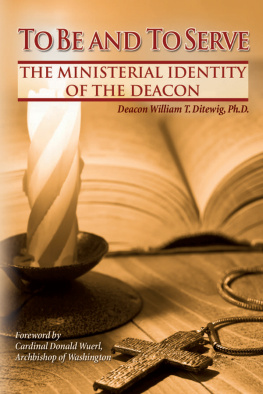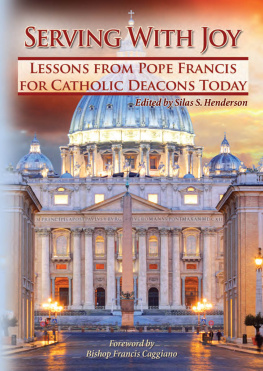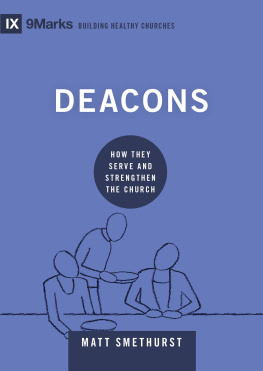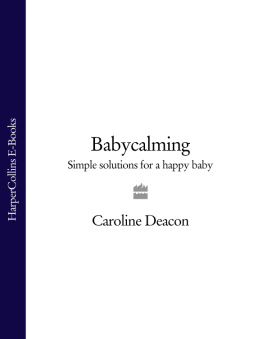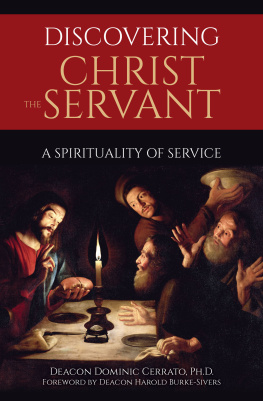To Be and To Serve
The Ministerial Identity of the Deacon
Deacon William T. Ditewig, Ph.D.

C HAPTER I
What IS Ministerial Identity?
Theologian John Ford, along with others, has pointed out the rather imprecise uses of the term ministry. The word itself comes from the Latin ministerium which in turn translates from the Greek diakonia: service. If the terms are not qualified in some way, it can be hard to sort out just what kind of ministry or service were talking about. Consider just a couple of quick examples. Government officials are often referred to as ministers, for example. In diplomatic service, ambassadors and legates are likewise called ministers. Within the world of the church, ministers are those who conduct religious services and provide related services to those they serve. Prior to the Second Vatican Council, the term ministry was generally associated with clergy of religions other than the Catholic Church: those folks had ministers, while we Catholics had priests, sisters, and brothers.
With regard to deacons, whose very name means servants, it is interesting that one of the early patristic sources on the diaconate observed that deacons are not ordained to the priesthood, but into service to the bishop [non ad sacerdotium sed in ministerio episcopi], to do that which he commands. That service, that ministry, could now take a wide variety of forms.
While the forms of ministry associated with the Catholic deacon are many and varied, they are of secondary importance to us in this brief reflection on the ministerial identity of the deacon. What we are looking for is the foundation upon which the deacons service rests.
Identity
Hamlet had it right: To be, or not to be? That really is the question.
What does it mean to be? What does it mean to be a particular person in Gods creation? In this book, we will reflect on the specific question of what it means to be a deacon ordained for service by the Catholic Church. Often, when we speak about ministry in the Church, we hear about the functions being performed: lectors read, Extraordinary Ministers of Holy Communion distribute, catechists catechize, and deacons, well deacon. But the real question is not what do we do? but who are we when we do it?
As Christians, we look to Christ as the model of ministry. He taught; but, many other people were also teaching. Christ healed the sick; but, there were other healers, other prophets, and other religious leaders all around. What made Christs teaching, healing, prophesying, so unique? It was not what he was doing as much as who He was as he did it! They were astounded at his teaching, because he spoke with authority (Luke 4:32). Christs actions had authority because of who he was: the Messiah, the Son of the Living God (Matthew 16:16). As disciples of Christ, the same can be said of us. The various forms of our service rest on the solid foundation of who we are as followers and imitators of Christ.
Before going deeper into this relationship, lets put it into perspective. All kinds of people do many of the same things that we do, but they do them out of a different identity; their actions flow from a different foundation. Catholics are, of course, not the only people who serve; religious people are not the only people who care and act with compassion and generosity! Let me give an example.
Many years ago, I was asked to be a part of a panel of religious leaders addressing a large group of hospice volunteers. I was the Catholic member of the panel, along with a rabbi and a Lutheran minister. Our task was to give the participants some sense of the traditions of our respective faiths with regard to death and dying. Before we began, the three of us decided that we should find out the religious orientations of the audience. The pastor asked how many people identified themselves as members of Protestant churches. Only a handful of people raised their hands. Even fewer identified themselves as Catholic, so the rabbi thought he had us both beat, but no one there identified themselves as Jewish. In other words, out of the nearly one hundred people in attendance, fewer than 25% were there because of particular religious convictions. When we asked why they were involved in hospicewhat motivated them to do thatone woman spoke up that it was simply the right thing to donot from any particular religious perspective, but simply because human goodness and concern demanded it. Their ministerial identity was not based on religious discipleship, but a sense of civic responsibility and generosity.
So we come back to our fundamental question: what does it mean to be a deacon? Specifically, what does it mean to be a deacon of the Catholic Church? Not, what do deacons do? but who are deacons? It has become almost clich to hear deacons say, Its not about what we do, but about who we are. Exactly. But we need to examine that ministerial (diaconal) identity more closely.
Baptism
It all starts with baptism.
When a deacon candidate is called to ordination, according to the instructions in the liturgical books, he is to vest in an alb. Think about that for a moment. The albthe long white robe worn by a variety of ministers, lay and ordainedis the foundational vestment we wear. Altar servers in many locations wear them. Newly baptized adults wear them. Bishops, deacons, and presbyters wear them. Even the pope wears them. The alb is not a clerical vestment; by that, I mean that it is not a vestment worn only by the clergy. The significance of the alb is found in the fact that it represents the white garment given to us at our baptism. I sometimes think it would be wonderful to see every baptized person come to Sunday Mass dressed in albs. What a striking way to show each other that we are a community of the baptized!
It is over this foundation (i.e. the baptismal garment) that we who are ordained place the vestments unique to our office: the stole and dalmatic for the deacon, the stole and chasuble for the presbyter and bishop (although sometimes the bishop will wear both the dalmatic and the chasuble on solemn celebrations). So, the first element of the ministerial identity of any Christian is found in the waters of baptism.
In the waters of baptism we are immersed into the very life of the Trinity, filled with and consecrated by the Holy Spirit. Anointed with Sacred Chrism, we are charged with the words: God the Father of our Lord Jesus Christ has freed you from sin, given you a new birth by water and the Holy Spirit, and welcomed you into his holy people. He now anoints you with the chrism of salvation. As Christ was anointed Priest, Prophet, and King, so may you live always as a member of his body, sharing everlasting life.
There it is: by baptism, we join in Christs own identity as priest, prophet, and king.
I have always been humbled and challenged by part of a homily by the great Fourth Century bishop, Augustine of Hippo:
For you I am a bishop; with you, after all, I am a Christian. The first is the name of an office undertaken, the second a name of grace; the first means danger, the second salvation. Finally, as if in the open sea, I am being tossed about by the stormy activity involved in the first; but as I recall by whose blood I have been redeemed, I enter a safe harbor in the tranquil recollection of the second; and thus while toiling away at my own proper office, I take my rest in the marvelous benefit conferred on all of us in common.

